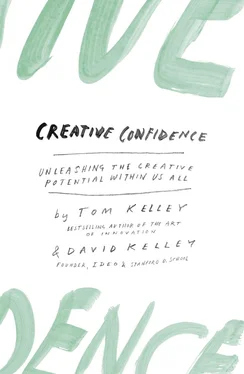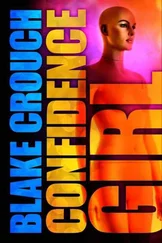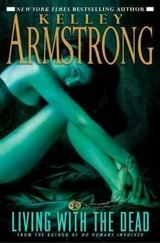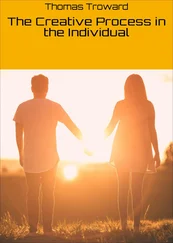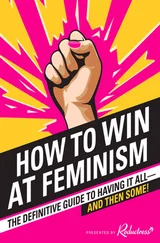Creative energy is one of our most precious resources.
• A former Olympian entered the airline industry and developed the confidence to tackle her company’s crisis management problems head on. She gathered a volunteer task force of pilots, dispatchers, crew schedulers, and others to prototype procedures following weather-related flight disruptions, leading to a 40 percent faster recovery time.
• An army captain who served in Iraq and Afghanistan rallied over 1,700 people to petition for a pedestrian mall in the local community, proving you don’t have to be a general to have an impact.
• Going beyond just the raw facts of a case, a law school student took a human-centered approach to her mock trial. She had the jury picture themselves at the scene of the incident to imagine what it felt like. And through harnessing their empathy, she won—the first time a jury had ever favored her side of that particular case.
• A former government executive started a grassroots innovation movement in Washington, D.C., that has grown to over a thousand members. Through workshops and networking events, she is spreading her new perspective on organizational change to other leaders and aspiring entrepreneurs.
• After four decades of experience, an elementary school teacher restructured her curriculum into design challenges. Instead of teaching discrete subjects, she created projects that covered the same topics but got students to step away from their desks and think more critically. Their test scores improved, but more important, parents noticed their children were more engaged and inquisitive.
You don’t have to switch careers or move to Silicon Valley to change your mindset. You don’t have to become a design consultant or quit your job. The world needs more creative policy makers, office managers, and real estate agents. Whatever your profession, when you approach it with creativity, you’ll come up with new and better solutions and more successes. Creative confidence can inspire whatever work you already do—because you gain a new tool to enhance your problem-solving practices without having to abandon any of your existing techniques.
You don’t have to switch careers or move to Silicon Valley to change your mindset.
We’ve talked to doctors who have found new ways to empathize with and more effectively treat their patients, looking beyond the surface symptoms. We’ve talked to executive recruiters who use our methods to find new matchups between talented people and the companies that need them most. We’ve talked to social workers who use human-centered approaches to help people in the community understand confusing application forms.
People with creative confidence have a greater impact on the world around them—whether that means getting involved with their child’s school, turning a storage room into a vibrant innovation space, or harnessing social media to recruit more bone marrow donors.
As legendary psychologist and Stanford professor Albert Bandura has shown, our belief systems affect our actions, goals, and perception. Individuals who come to believe that they can effect change are more likely to accomplish what they set out to do. Bandura calls that conviction “self-efficacy.” People with self-efficacy set their sights higher, try harder, persevere longer, and show more resilience in the face of failure.
Our practical experience in the world of innovation and creative confidence aligns closely with his findings. When people transcend the fears that block their creativity, all sorts of new possibilities emerge. Instead of being paralyzed by the prospect of failure, they see every experience as an opportunity they can learn from. The need for control keeps some people stuck at the planning stage of a project. With creative confidence, they become comfortable with uncertainty and are able to leap into action. Instead of resigning themselves to the status quo, or what others have told them to do, they are freed to speak their mind and challenge existing ways of doing things. They act with greater courage, and have more persistence in tackling obstacles.
We believe this book will help you overcome the mental blocks that hold back your creativity. Chapter by chapter, we will give you tools that empower you to pursue new ideas with confidence. The stories, methods, and practices that we will share draw on decades of collaboration with creative thinkers everywhere, and we believe they will help you too.
THE CREATIVE CONFIDENCE QUEST
Today, our mission as authors is to help as many people as possible rediscover their creative potential.
Confronted with their newfound creativity, people sometimes confide in us that their mother was a dancer, or their father was an architect. They seem to be rationalizing their spark of creative energy, as if they are searching for concrete evidence. What they don’t realize is that their creative potential was always a part of them—not because of any family history or genetic predisposition, but because it is a natural human ability within us all.
Creative confidence is a way of seeing that potential and your place in the world more clearly, unclouded by anxiety and doubt.
We hope you’ll join us on our quest to embrace creative confidence in our lives. Together, we can all make the world a better place.
* A note about “we”: This book has two authors, so you will see the first person plural a lot . When talking about just one of us, we will say “David” or “Tom.” In some contexts, however, the “we” will mean the team at IDEO, where the two of us work, or the faculty and staff of the d.school, where David spends time.
Конец ознакомительного фрагмента.
Текст предоставлен ООО «ЛитРес».
Прочитайте эту книгу целиком, купив полную легальную версию на ЛитРес.
Безопасно оплатить книгу можно банковской картой Visa, MasterCard, Maestro, со счета мобильного телефона, с платежного терминала, в салоне МТС или Связной, через PayPal, WebMoney, Яндекс.Деньги, QIWI Кошелек, бонусными картами или другим удобным Вам способом.
